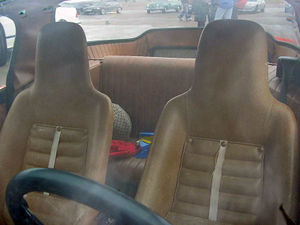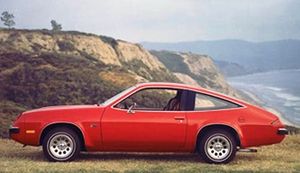Difference between revisions of "2 plus 2"
m (Created page with '{{X}} The term '''2+2''' (pronounced "two plus two") is a phrase used to describe the configuration of a car with seating for ''two'' pass…') |
|
| (One intermediate revision by the same user not shown) | |
(No difference)
| |
Latest revision as of 20:18, 27 September 2009
The term 2+2 (pronounced "two plus two") is a phrase used to describe the configuration of a car with seating for two passengers in the front, plus two smaller seats for occasional passengers (or children) in the rear.
Description
A 2+2 has just two rear seats rather than the more common three. Reasons for this may include a car's more sporty nature, typical low roof line, wide wheel arches, and (because of being front engined with rear-wheel drive or four-wheel drive) wide central transmission tunnels, the last of these being the most pressing problem for a third (middle) seat. The Porsche 911 is a rear engined, rear wheel drive, so it lacks a large transmission tunnel, but loses space in the rear due to its wheel arches, reducing the space to 2 passengers.
Space in the rear is most noticeably absent in terms of longitudinal leg-room. This is again often due to the low roof line, and other elements of body styling, in addition to large engine compartments and sometimes also large areas given over to the convertible roof in the case of a 2+2 convertible.

Many vehicles may fall into the definition, and there is no official body offering a strict definition, but cars called 2+2s must have:
- only seats for 2 rear passengers rather than the common 3;
and also strongly tend to have:
- relatively little room in the back even for 2 passengers;
- a more sporting nature (or at least style) than the average vehicle;
- coupé-like bodies;
- two doors.
Many convertible, targa top and hatchback cars are strictly within this definition, but are rarely deemed 2+2s. Few cars have ever been specifically marketed as 2+2s — most prominent are the classic Jaguar E-type fixed-head coupé 2+2, the Lotus Elan +2, the Nissan 300ZX 2+2, the Chevrolet Monza 2+2 and the Pontiac 2+2 models, including the aerodynamic Grand Prix of NASCAR fame.
Variations
The TVR Cerbera has its front passenger seated slightly forward to allow more room for a passenger in the back, as well as having very large side doors to make access to the rear seats easier. This configuration is unofficially known as a "3+1".
The Mazda RX-8 has two small "half-length" rear suicide doors to make access to the back seats easier. Note that, in this case, "2+2" still refers to the seating layout and, in no way, to the additional 2 "half-length" rear doors.
Examples of cars marketed in a 2+2 version
- These are examples, and are not intended to represent a complete list.
- Chevrolet Monza 2+2
- Datsun 260Z and 280Z
- Ferrari Mondial
- Ferrari 456M GT
- Infiniti G35 Coupé
- Jaguar E-Type 2+2
- Lotus Evora
- Maserati Ghibli II Coupé
- Maserati Gran Turismo Coupé
- Mazda RX-7
- Mazda RX-8
- MGB GT
- Mitsubishi Eclipse
- Mitsubishi 3000GT
- Nissan 240SX
- Nissan 300ZX
- Nissan GT-R
- Pontiac Firebird
- Porsche 924 / Porsche 944 / Porsche 968
- TVR Cerbera
- Volvo 1800
See also
- Car body style and particularly:
- Car classification
